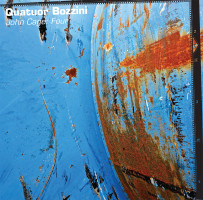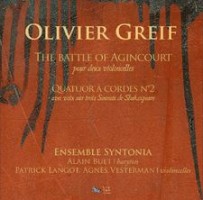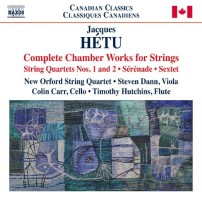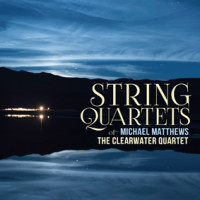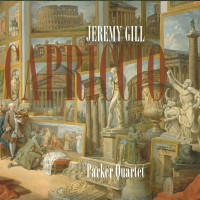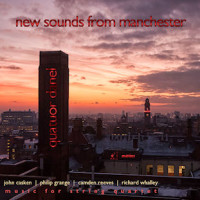String Theory 13: 19 Quartets, etc.
|
Grant Chu Covell [November 2015.]
John CAGE: String Quartet in Four Parts (1949-50); Thirty Pieces for String Quartet (1983); Four (1989). Quatuor Bozzini: Clemens Merkel, Mira Benjamin (vln), Stéphanie Bozzini (vla), Isabelle Bozzini (vlc). Collection Quatuor Bozzini CQB 1414 (1 CD) (http://www.quatuorbozzini.ca/). As a collection, Cage’s string quartets permit an ensemble to explore different ways of collaborating. The String Quartet in Four Parts was written just before Cage’s plunge into chance. It’s traditionally notated and organized akin to the micro and macro structures Cage explored in his early percussion music. The Bozzini pivots expertly between delicate antique and dissonant chords. Thirty Pieces and Four are from the same decade, however are separated by a divide. Thirty Pieces consist of essentially 120 one-minute solos delivered four at a time. Each player prepares independently and in performance they coordinate as little as possible and spread themselves at far distances around the audience. It’s an accidental quartet; modern, aggressive, and lightly sprinkled with extended techniques and microtones. Four operates at a low threshold with neutral singularities. Chords and coincidences are expected but details are unpremeditated. Tones appear, unornamented, nearly expressionless and ugly. There’s a passage starting around 22:13 hinting at Mozart’s Dissonant. Here the Bozzinis demonstrate their impressive range, playing together, apart and indifferently.
Olivier GREIF: Sonate pour deux violoncelles, Op. 308, “The Battle of Agincourt” (1995)1; Quatuor à cordes No. 2 avec voix, Op. 312, “Sur trois Sonnets de Shakespeare” (1998)2. Alain Buet2 (bar), Ensemble Syntonia: Pascal Oddon2, Thibault Noally2 (vln), Anne-Aurore Anstett2 (vla), Patrick Langot1,2 (vlc); Agnès Vesterman1 (vlc). Zig Zag Territoires ZZT100401 (1 CD) (http://www.outhere-music.com/). Between the second and third expressive Shakespeare settings in the Second Quartet (Sonnets 71, 73 and 146, in English) suddenly erupts an unexpected jazzy, teasing Intermezzo. This surprising, seemingly uncharacteristic flamboyant moment demonstrates Greif’s precision craftsmanship and that his harmonic choices, sometimes antique, sometimes modern, are resolutely intentional. Otherwise, the quartet is predominantly liquid and intense. Sonnet 146, “Poor soul, the centre of my sinful earth,” expires like a requiem. The notes mention Greif’s interest in folk music, and attentive listening reveals subtle Eastern European touches near to Janáček, Bartók and perhaps further east. Vibrancy, especially in the visceral and presumably difficult cello duo, shows that Greif’s expressive music rewards performers and listeners. Ensemble Syntonia (in full force, a piano quintet) has taken a strong liking to Greif, releasing his complete works for violin and piano, and premiering his 50-minute Fourth Quartet, Ulysses, just one month before he died. [Walt covered this release here.]
Ruperto CHAPÍ: String Quartet No. 1 (1903); String Quartet No. 2 (1904). Cuarteto Latinoamericano: Arón Bitrán, Saúl Bitrán (vln), Javier Montiel (vla), Álvaro Bitrán (vlc). Sono Luminus DSL-92185 (1 CD) (http://www.sonoluminus.com/). Chapí’s claim to fame included zarzuelas (his biggest hit was the 1897 La Revoltosa) and entertaining stage works. His 1877-79 Symphony is what a young Verdi might have written had he kept a glowering bust of Beethoven on the piano. Towards the end of his life Chapí (1851-1909) wrote four string quartets that do not advance the genre despite their serious mien. Beyond Nos. 1 and 2’s Classical four-movement structure, regional flavors may prevent some from taking them too seriously. These two bustle with liveliness even if their themes rarely undergo extensive development. They do explore the string ensemble’s colors with deftly scored unisons, pizzicati and harmonics. Cuarteto Latinoamericano plays with great comfort and care. These two are about 35 minutes each. We should hope Nos. 3 and 4 are waiting in the wings.
“Complete Chamber Works for Strings.” Jacques HÉTU: String Quartet No. 1, Op. 19 (1972); String Quartet No. 2, Op. 50 (1991); Scherzo, Op. 54 (1992); Adagio and Rondo, Op. 3, No. 1a (1960); Sérénade, Op. 45 (1988)*; Sextet, Op. 71 (2004)**. New Orford String Quartet: Jonathan Crow, Andrew Wan (vln), Eric Nowlin (vla), Brian Manker (vlc); Timothy Hutchins* (fl), Steven Dann** (vla), Colin Carr** (vlc). Naxos 8.573395 (1 CD) (http://www.naxos.com/). Contrasting his First and Second, we hear that Hétu (1938-2010) moved from a dry modernism towards a vastly more expressive style. The First presents studious organization; both quartets extend Debussy, the Second more so which also touches bittersweet Schubert in the concluding Andante. There must be a story behind the standalone six-minute Scherzo with its varied material including the briefest Goldberg Variations allusion. Hétu’s earliest essay in the genre, an Adagio and Rondo, demonstrate expressive dissonance and Bartókian precedents. The three-part Sérénade for string quartet and flute takes inspiration from Shakespeare’s Merchant of Venice. There is more foreboding than beauty despite the floating flute. The string Sextet offers six weighty variations on an original theme. The New Orfords are fine advocates for Hétu especially in No. 2.
Michael MATTHEWS: String Quartet No. 3 (2008; rev. 2013); Miniatures (2000); String Quartet No. 2 (2002-03). The Clearwater Quartet: Gwen Hoebig, Daniel Scholz (vln), Karl Stobbe (vla), Yuri Hooker (vlc). Ravello Records RR7910 (1 CD) (http://www.ravellorecords.com/). Bartók comes to mind upon encountering Matthews’ Third because of its economical organization. With four movements of roughly equal size, Matthews conducts an austere argument without stringent dissonance. The notes keenly observe that excellent construction need not imply conservatism, but then glibly wanders onto a minefield to make distracting connections with Shostakovich, Freud, Beckett, the Holocaust, etc. Perhaps Matthews’ quartets express a Canadian response to the European Zeitgeist, but they are effective in the absolute. The 11 Miniatures pass in 13 minutes. These small chips may be thematically isolated but as a series suggest a fractious existence, vociferous complaints on esoteric subjects. The Second quartet projects an interesting two-part structure in three movements. The first and second taken together are balanced in size and demeanor by the final contemplative Adagio. The Clearwater Quartet is certainly up to the cold, icy plunge.
Jeremy GILL: Capriccio (2012). Parker Quartet: Daniel Chong, Ying Xue (vln), Jessica Bodner (vla), Kee-Hyun Kim (vlc). Innova 913 (1 CD) (http://www.innova.mu/). Gill admits writing for string quartet is hard: “Composing Capriccio was itself a bizarre experience (string quartets are famously difficult for composers).” However, he acquits himself admirably. A partnership with the Parker Quartet resulted in 27 varied movements in two parts for an hour-long opus. There’s a didactic element at play in that some movements illustrate various stringed instrument tendencies, particularities of bowing, fingering or other gestures. There are extended solos and sections within movements that cover all possible string trio combinations. Subtle or blatant references (Beethoven, Saint-Saëns, Bartók et al.) come into orbit then veer away. A few interludes by Carlo Farina, Jacquet de Berchem and J.S. Bach introduce other Capriccios. However, this is not an esoteric Music History class, but an eclectic curio cabinet worth close inspection.
“New Sounds from Manchester.” Camden REEVES: String Quartet No. 1, “Fireworks Physonect Siphonophore” (2009); String Quartet No. 2, “Dactylozooid Complex” (2011). Richard WHALLEY: Interlocking Melodies (2007). John CASKEN: Choses en moi (2003). Philip GRANGE: Ghosts of Great Violence (2012). Quatuor Danel: Marc Danel, Gilles Millet (vln), Vlad Bogdanas (vla), Guy Danel (vlc). Metier MSV 28546 (1 CD) (http://www.divineartrecords.com). Who would expect such consistent intensity and boldness to emerge from the University of Manchester, where these four composers teach composition and where the Quatuor Danel has been in residence since 2005. Reeves’ quartets make the biggest impression notwithstanding their fascinating titles. No. 1 is a tidy single movement with a false ending. Built from repeating spiral phrases, it recalls a climbing gesture from Carter’s First. The title is the name of a sea organism in the jellyfish family, one of the longest creatures ever observed, which really does look like fireworks. An engaging sequel, No. 2 explores the same curvaceous cells. But the three movements, which gently double as they proceed (1:14, 3:31, 6:26), cover more terrain. Each movement begins fast and ends slow, but the amount of fast and slow varies. Bursts are balanced by repose, progress is definite, but the plan is obscure. This one is also named after a jellyfish. Whalley and Casken’s quartets are brief single statements. Dedicated to Ligeti whose piano Étude patterns are in evidence, Whalley’s Interlocking Melodies offer a delicate unfurling derived from interlocking whole tone scales tuned a quarter-tone apart. A painting by Willem de Kooning inspired the piece which surprises because the quartet is not abstract. Casken’s Choses en moi takes a piano set by Prokofiev as its starting point. The most extended item is Grange’s 30-minute four-movement Ghosts of Great Violence. Reflecting upon the Somme battlefields which saw bloodshed and remain haunted places today, this would be the most classical of the five. Grange’s second movement was inspired by a John Singer Sargent painting, Gassed.
[Previous Article:
Armchair Operas and Amusements 11.]
[Next Article:
Fresh Ferrari]
|
